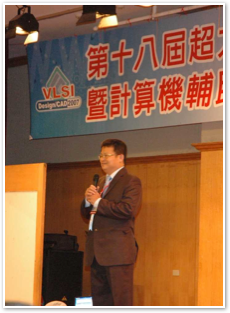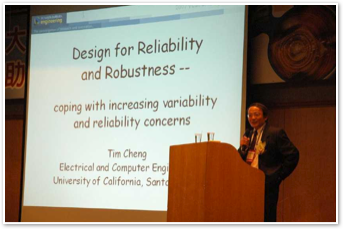

CONFERENCE NEWS
18th VLSI Design/CAD Symposium, August 2007, Hualien, Taiwan
The 18th VLSI Design/CAD Symposium (2007 VLSI/CAD) was held during Aug. 8~10, 2007, at Parkview Hotel, Hualien, Taiwan. This symposium is aimed at providing an open forum for professors, industrial engineers, and most important of all, graduate students to exchange cutting-edge RD knowledge and ideas in the field of SOC/ASIC design and EDA research. Taiwan has been renowned as one of the IC design power houses globally. Besides the leading semiconductor foundries, e.g., TSMC and UMC, IC design as well as CAD/EDA research capability of Taiwan have gradually been recognized. One of the reasons is that this annual symposium plays an important role to stimulate researchers and drive them to march forward.
 The city where the symposium was held is Hualien. It is one of the most gorgeous cities in Asia Pacific. Hualien is sitting between the Pacific Ocean and the Central Mountain of Taiwan. It is about 5 hours drive from Taipei, the capital of Taiwan. The symposium hotel, i.e., Parkview Hotel, which is a 5-star resort and hotel, is located at the north part of Hualien. Parkview Hotel has a ballroom to accommodate more than 800 people at the same time besides 8 medium-sized conference rooms, which make her a very good choice to host an important symposium.
The city where the symposium was held is Hualien. It is one of the most gorgeous cities in Asia Pacific. Hualien is sitting between the Pacific Ocean and the Central Mountain of Taiwan. It is about 5 hours drive from Taipei, the capital of Taiwan. The symposium hotel, i.e., Parkview Hotel, which is a 5-star resort and hotel, is located at the north part of Hualien. Parkview Hotel has a ballroom to accommodate more than 800 people at the same time besides 8 medium-sized conference rooms, which make her a very good choice to host an important symposium. The success of a symposium undoubtfully depends on the program and the paper quality to present. After the attractive opening ceremony addressed by General Chair, Prof. Chua-Chin Wang of National Sun Yat-Sen University, on Aug. 8 morning, Prof. Chung-Yu Wu, who is now President of National Chiao Tung University, gave his keynote speech entitled as “What Happens Next? When Engineering Falls in Love with Biology, Medical Science, and Life Science.” The cutting-edge vision chip design developed by his research team is presented to the attendees. After a short coffee break, an invited talk, “Design for Reliability and Robustness - Coping with Increasing Variability and Reliability Concern,” was addressed by Prof. Kwang-Ting Tim Cheng of UC Santa Barbara. He pointed out the rising cost of DFT and DFM in the next decade, which is a problem that IC designers and researchers have to deal with shortly in a near future. Following Prof. Cheng’s talk, another invited talk, “An SoC for Biomedical Wireless Sensor Network,” was then given by Prof. Shey-Shi Lu of National Taiwan University. He highlight the latest SoC solution for the nodes used in a wireless sensor network, which will become the next inter-discipline research topic between biomedical and electronics.
 The total number of accepted papers is 178, where 90 papers are equally distributed in 15 oral sessions and the other 88 paper are scattered over 3 poster sessions. Particularly, we organized 3 “Live Demo” sessions where SOC systems were physically presented on chips or boards. The presenters of Live Demo sessions are widely from Korea, brand-named IC design companies, and medalists of national IC/IP design contests. They are so welcomed that the entire ballroom was packed all the time during the sessions.
The total number of accepted papers is 178, where 90 papers are equally distributed in 15 oral sessions and the other 88 paper are scattered over 3 poster sessions. Particularly, we organized 3 “Live Demo” sessions where SOC systems were physically presented on chips or boards. The presenters of Live Demo sessions are widely from Korea, brand-named IC design companies, and medalists of national IC/IP design contests. They are so welcomed that the entire ballroom was packed all the time during the sessions. Annual meetings of IEEE CASS and SSCS of Taipei and Tainan Sections are also held in this symposium. CASS Taipei Chapter Chair, Prof. Tzi-Dar Chiueh, and CASS Tainan Chapter Chair, Prof. Chua-Chin Wang, hosted the annual joint meeting of CASS together to address the current and future activities of CASS. Later in the same evening, SSCA Taipei Chapter Chair, Prof. Shen-Iuan Liu, and SSCS Tainan Chapter Chair, Prof. Chua-Chin Wang, hosted the annual joint meeting of SSCS members. Besides the announcement of call-for-paper of ASSCC and ISSCC, another important topic is to increase the number of society members.
 In addition to the broad technical program, the local organizers, under the leadership of General Chair, particularly organized social activities for the conference attendees. Two half-day city tours of Hualien and another two full-day tours in nearby suburban area through the breathtaking scenic mountain and ocean ranges of eastern Taiwan, including Taroko National Park and Bai-Baw River, are provided at the choice of attendees. However, my own personal highlight of this symposium in Hualien is the magic show and the gourmet seafood in the banquet, where all of the attendees were so much impressed to keep saying that the symposium should do this more often.
In addition to the broad technical program, the local organizers, under the leadership of General Chair, particularly organized social activities for the conference attendees. Two half-day city tours of Hualien and another two full-day tours in nearby suburban area through the breathtaking scenic mountain and ocean ranges of eastern Taiwan, including Taroko National Park and Bai-Baw River, are provided at the choice of attendees. However, my own personal highlight of this symposium in Hualien is the magic show and the gourmet seafood in the banquet, where all of the attendees were so much impressed to keep saying that the symposium should do this more often. Details of the symposium program and organization team can be found in http://www.ee.nsysu.edu.tw/vlsi2007/.
Chua-Chin Wang, General Chair of 2007 VLSI Design/CAD Symposium and Tainan CAS Chapter Chair, Taiwan (Email: ccwang@ee.nsysu.edu.tw)



